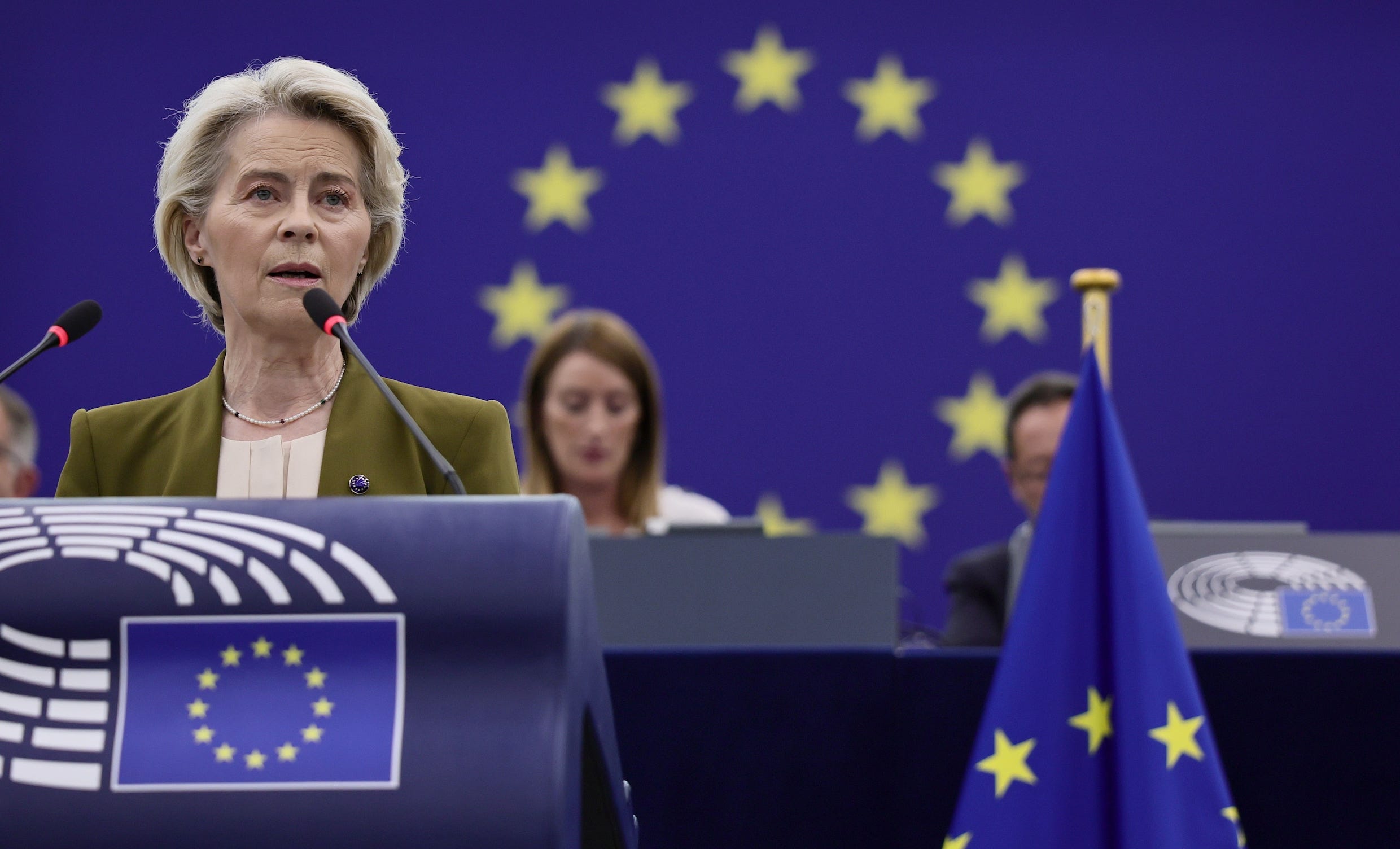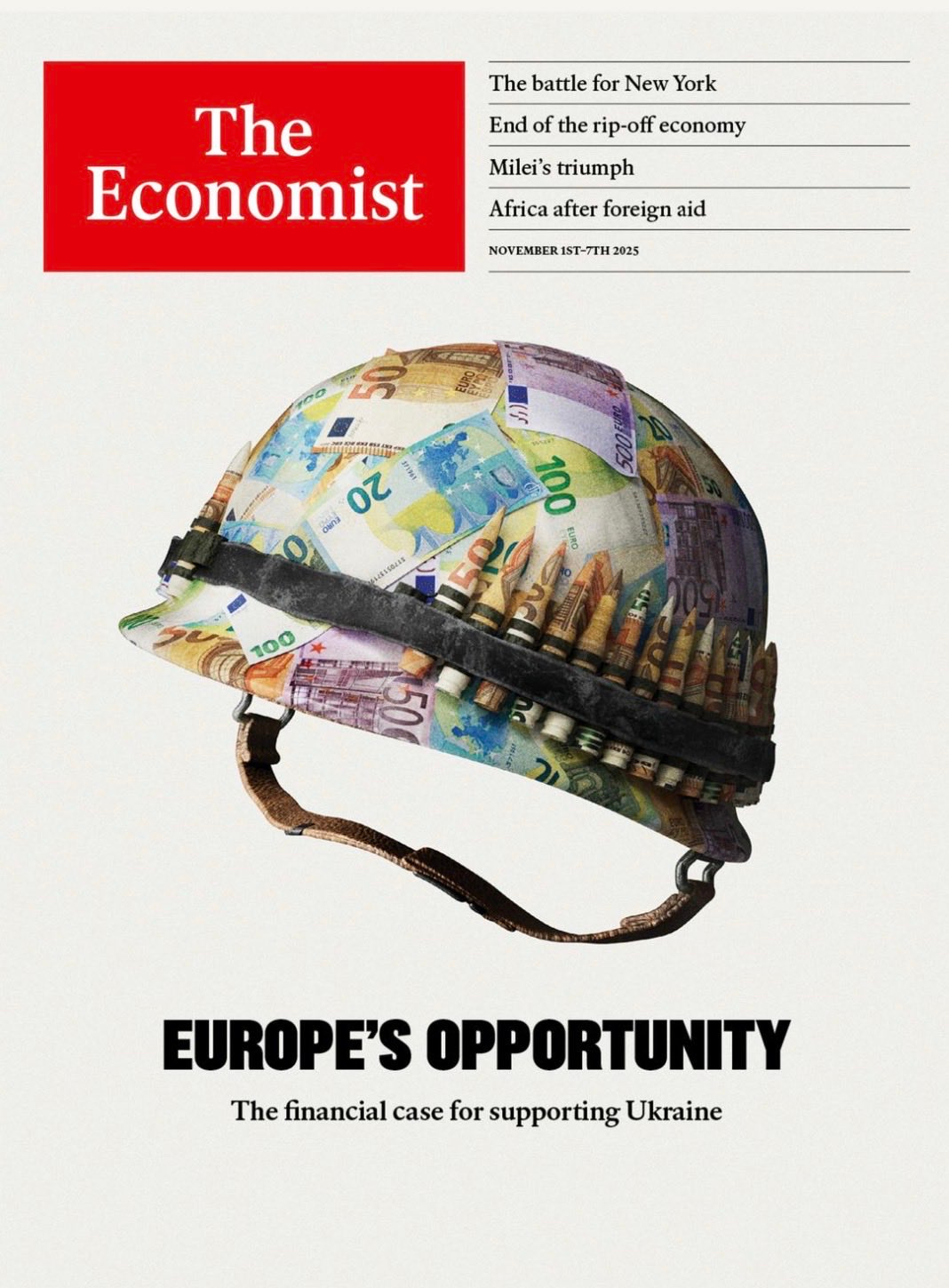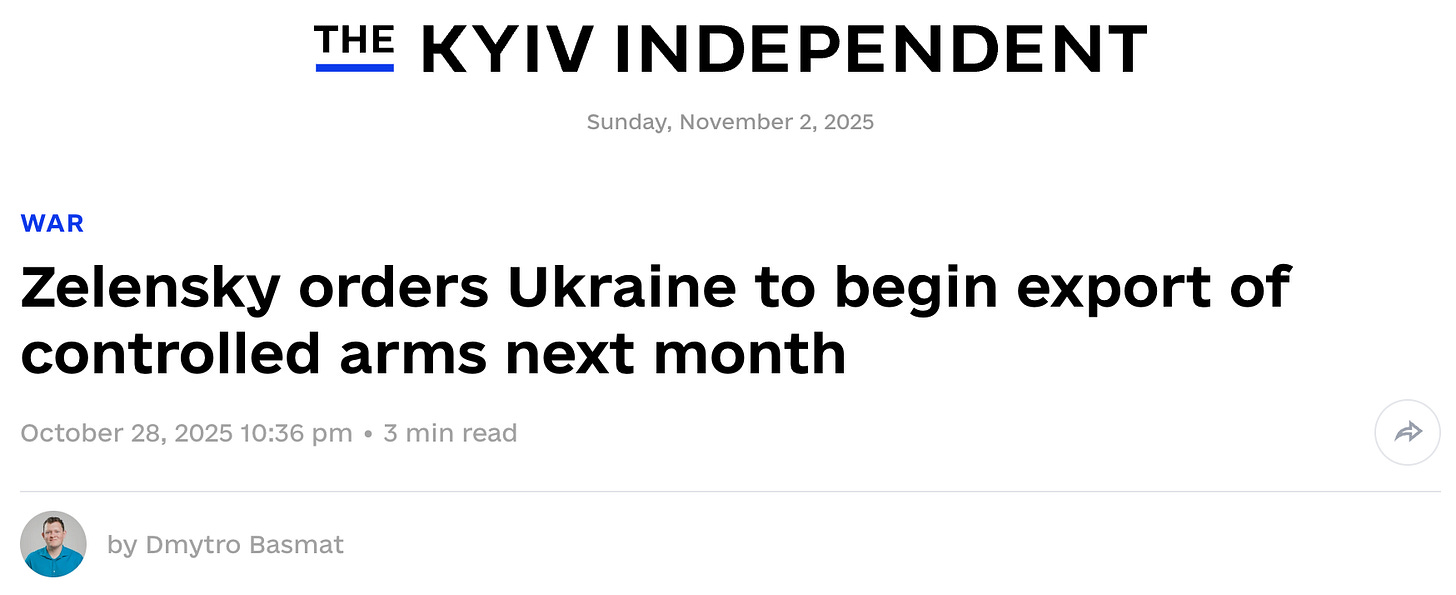Eurobonds, Budget Gaps, and War Until 2031
Untangling media narratives on Europe's role in the war
Today’s post will serve as an update to my recent pieces on the European military-industrial complex, the Ukrainian budgetary crisis, and the energy attrition war. In an amazing coincidence, today’s issue of The Economist addresses all three of these subjects with a quartet of remarkable articles. These pieces broadly agree with facts of the situation as I’ve outlined over the past few weeks. Their conclusions, however, are entirely different. We’ll use these pieces to get a sense of what the Atlanticist elite is thinking.
Saving Ukraine
First, a pair of pieces that echo all the major points in my analysis of European defense spending.
In the first piece, Saving Ukraine, the author (Economist writers are always anonymous) doesn’t pull any punches when describing how desperate Ukraine’s funding gap is, calling it a “savage cash crunch.” While my piece on the Ukrainian budget deficit echoed other estimates that the Ukrainians will run out of funding as late as the end of the first quarter of 2026, The Economist paints a closer D-Day: the end of February.
Two out of three of Ukraine’s funding sources are “drying up,” according to the piece, with the American money faucet slowing to a trickle, while issuing additional Ukrainian debt is becoming untenable, as Ukraine has “now borrowed as much as anyone will lend it.” This leaves Europe holding the bag.
Echoing the language I used in my piece on Ukrainian funding, the article describes the prospect of using loans backed by frozen Russian assets as “exposing the divisions inside the EU.” Belgium is threatening to hold up the plan, while “Northern” EU countries are averse to issuing new bonds, as it could “undermine fiscal discipline.” The French fear that new debt raised for Ukraine will simply be sent to the US for weapon procurement, destroying the European return on investment. And lastly, “everyone” fears a new “blank cheque” given to the Ukrainians will just worsen its already severe corruption.
These concerns are irrelevant, the author insists:
These anxieties are reasonable, but they are dwarfed by two gains that lie within Europe’s grasp. The first is a financial commitment that can expose and amplify the Kremlin’s longterm weak-ness. Russia has lost the lives of 200,000-500,000 troops—double the figure for Ukraine. It is also bearing a heavy financial burden on its own. Declared defence spending will hit $160bn in 2025, and state-run banks have also engaged in an immense off-budget lending spree to support the military-industrial complex. It is true that sanctions in 2022 failed to bring Russia to its knees as some had hoped. But Mr Putin’s initial war boom has now given way to stagflation, with growth at almost zero, labour shortages, hidden bad debts, inflation of 8% and interest rates of 16.5%. Another half-decade of this would probably trigger an economic and banking crisis in Russia. If Europe can demonstrate to Russia that it will underwrite the war for at least that long, Mr Putin will be cornered.
Forgive me for jumping straight to the end, but it contains a startling admission: another five years of brutal warfare in Europe would “probably” result in an economic crisis in Russia. It’s difficult to process this statement, or square it with headlines from The Economist itself – in March 2022, the Russian economy was “crumbling” and attempts to insulate it against sanctions were “in vain.” In April a Russian debt default was “almost inevitable.”
With Ukrainian sources universally reporting crippling manpower shortages, who precisely will be doing the frontline fighting for Ukraine in 2031? Is the unstated assumption here that teenagers and women will be next into the mobilization vans? How could nearly four years of economic isolation, proxy war, and nineteen sanction packages not even be half of what’s required to bring the Russian economy to its knees?
Even the casualty figures cited here are hard to make sense of. How can The Economist know that Ukrainian military deaths are half that of Russia’s if it can’t estimate Russian KIA to less than a 2.5-fold range? The publication sits at the apex of the Atlanticist elite media sphere, so if they don’t know, who does? And doesn’t the European population deserve to know exactly how many deaths Ukraine has suffered, considering they’re the ones being asked to foot the bill?
If we accept the description of Russia’s economic outlook given here, a cursory comparison to the European situation will raise serious questions. European defense spending is ballooning, and its banks have waived all normal lending standards to issue Ukraine billions in loans there’s no indication it’ll be able to pay back. European growth has stagnated, with German growth specifically being essentially zero. Russia’s debt-to-GDP ratio is lower than any EU country’s, and less than half the EU average. If a Russian crisis is on the (distant) horizon due to its military spending, why is military spending the solution for Europe? Consider too that the Russians, as is almost universally acknowledged now, seem to get twice the hardware or more in exchange for what they spend. It isn’t clear why the Europeans would win a military-industrial production spending race against the Russians. If anything, the reverse seems more likely.
As for the second reason the Europeans should be willing to dive head first into a debt-driven spending competition:
Europe’s second prize would be to become less dependent on America militarily, a necessity given Mr Trump’s wobbly commitment to NATO. Any long-term financing solution for Ukraine would help Europe build the financial and industrial muscle it needs to defend itself.
While this is a reasonable goal, it’s a long ways off. Untangling the complex web of arms deals, joint ventures, and NATO procurement contracts between the US and Europe is almost impossible, but imports from the US continue to form a large percentage of European defense spending. As I covered in my most recent piece, unless that percentage declines rapidly, European spending on defense has little chance of being an efficient way to drive economic growth. And no European country except France is currently capable of domestically producing nuclear weapons without US help. How independent can the Europeans reasonably be expected to become? And how long will it take? Given that the justification for this independence is a fundamentally American military adventure that has resulted in the EU being cut off from its most affordable source of energy imports – imports it’ll need to become self-sufficient – it’s hard to make sense of this.
In the second piece, titled Ukraine’s War Bill, the author compares Europe’s defense situation with regard to Ukraine to the one NATO faced with the USSR:
“History teaches that wars begin when governments believe the price of aggression is cheap,” argued President Ronald Reagan in 1984. He oversaw a vast increase in America’s defence budget that the Soviet Union could try to counter only by wrecking its economy. By the end of the decade the “evil empire” was collapsing.
The idea that the USSR collapsed primarily due to excessive defense spending is an old trope, and one contested by some historians. Regardless, what’s absent here is an explanation of why Reagan’s axiom would be to the detriment of modern-day Russia, which is spending significantly less on its war effort while also producing more, dollar for dollar, than the Euro-Ukrainian axis, and while simultaneously generating significantly less debt. In other words, why is Europe any less likely to spend itself into collapse than Russia?
The author highlights how dire the situation really is. Without US cash, the Europeans will be left footing almost all of Ukraine’s skyrocketing bills, but this is essential to communicate to Putin that “he cannot win a long war.”
The task is daunting. We calculate that Ukraine will need approximately $389bn in cash and arms over the four years from 2026 to 2029 (for consistency we are using dollars and constant prices throughout), mainly from Europe. That is almost double the roughly $206bn that Europe has supplied since just before the war started in February 2022… Whether Europe rises to this challenge will be a test of its aspirations to “strategic autonomy”, by which it means it can act in its own foreign-policy interests without depending on America (or China).
The unsupported presupposition here is that a kind of collective self-interest is at play with the European bloc’s decision to back Ukraine to the hilt, even in the absence of American financial support. An explicit explanation of precisely why it’s in Europe’s interests to prolong the war is surprisingly hard to come by, considering how fundamental to all of this it is. And what – or who – is “Europe,” precisely, with regard to this discussion? Is it the European people as a collective? The Atlanticist ideological bloc? The European markets? The EU’s bureaucratic elite?
Answering this is difficult, because it requires explaining how an American project can seamlessly transform into a European one, even with the Americans going their own way. US support for a nascent, independent Ukraine dates back 25 years, from media funding prior to the Orange Revolution, to Victoria Nuland’s infamous “fuck the EU” phone call during Euromaidan. The Ukrainian project could be described as Atlanticist, American, or even – considering the devastating consequences for European economies – outright anti-European. But the author of this piece suggests, without explanation, that prolonging the war is inherently in European self-interest.
Next, the piece hits us with a barrage of financial estimates. Ukraine’s defense spending is currently $65 billion, around half of its total budget, and with $90 billion in government revenues, the country is running a $50 billion annual deficit. Ukraine’s spending has been increasing at 20% a year, which is around two thirds of Russia’s spending (though they say Russians may be spending twice as much as they’re publicly stating). Then, the bombshell: The Economist suggests Europe will need to give the Ukrainians an eye-watering $389 billion in military, budgetary, and reconstruction aid over the next four years, with $328 billion coming from the EU and $61 billion from Britain.
The EU has thus far only committed to a paltry $15 billion in direct aid over the next two years, while the IMF has pledged $10 billion. The first two pieces both back the idea of issuing a “reparation loan” guaranteed by frozen Russian assets, but note that the $160 billion it would provide isn’t even half what the Ukrainians need. EU budgets are tapped out, and could only provide $30 billion a year, and not without significant financial pain. The solution for increasing this amount by a factor of 16 times is to take on debt, issuing new Eurobonds, distributing the liability across the entire continent. Bonds would “deepen Europe’s single capital market” and “boost the role of the euro as a reserve currency.” But even $389 billion won’t be enough, says the author of the second piece, because Ukraine will need to replenish its ammunition stocks and “maintain a standing army” for deterrence after the war ends in a Ukrainian victory.
The second piece also hints at growing fault lines within the European-Ukrainian fiscal relationship. German chancellor Friedrich Merz apparently is only willing to issue Ukraine the reparation loan if the entirety of that loan goes towards buying weapons, instead of plugging the sizable hole in the Ukrainian budget. The author suggests Merz may be angling to get more far-flung “partners” like Japan or Canada to step up and pay Ukraine’s bills. The Ukrainians themselves reject any European control over how they spend the money, opposing Merz, and demanding they be allowed to purchase weapons from wherever they want. This isn’t going over well in Europe, where EU leaders in France and Germany are understandably nervous about taking on hundreds of billions in liabilities just for the proceeds to be funneled away to the US and beyond.
As the scope of the plan to save Ukraine increases to encompass the financial future of the entire EU, so too does the risk that one or two renegades might implode the entire initiative. The second piece quotes a German official who is particularly nervous about a veto threat from leaders like Viktor Orban. This is a real concern, as the objections to taking on such massive liabilities are eminently reasonable, and as evidenced by clearly vocalized worries from Belgium, France, and even Germany, dissent may grow.
Industrial Concern
The third piece is titled Europe’s Rocketing Defense Industry. This article makes some frank admissions that align with the observations I’ve made. First, Rheinmetall is absurdly overvalued, being worth nearly as much as Lockheed Martin despite generating just a sixth of the revenue:
An “era of rearmament” is under way in Europe, declared Armin Papperger, the boss of Rheinmetall, earlier this year. Investors in Germany’s defence champion certainly seem to think so. Since the start of the year its market value has rocketed from €27bn ($31bn) to €80bn, equivalent to 90 times its annual net profit and within shooting distance of Lockheed Martin, an American defence colossus… Rheinmetall generated revenue of just €10bn last year, a sixth as much as Lockheed Martin.
Second, the author concurs with our assessment that if any economic benefit is to be expected, the Europeans are underspending on defense research and development – European spending was €13bn in 2024 compared to American expenditures of $148 billion. The thrust of the piece is that the Europeans need to learn from the Americans, mirroring their military-industrial organization and spending. Air defense, long-range missiles, and rocket artillery production is “limited at best and absent at worst.” Increased cooperation on advanced systems, the author says, is a double edged sword – joint programs like the Future Combat Air System (a new drone swarm assisted European fighter jet) are plagued by “bickering,” though joint programs are necessary to stand a chance of matching the investment levels of American programs. Somehow, the Europeans need to find a way to be competitive.
Small, cutting-edge defense startups like the US’s Anduril are to be emulated, the piece says. Luckily, the Europeans have already demonstrated they can foster them – drone startups Helsing, Quantum Systems and Tekever are cited as examples. The author explains that private investors are helping get these off the ground, because banks are now “banging on the door” to break into the defense industry, which is now “almost glamorous” when it was once “a pariah.”
For those who have read my previous work, the objections to this assessment should be obvious. The US military-industrial complex, far from being a model to emulate, has proven itself wholly inadequate to the task of arming a military in a major peer war. The simplest munitions like unguided 155mm artillery shells are beyond its ability to produce in significant quantities, and it’s been unable to field an affordable analogue to the Shahed-136/Geran-2 platform. Its “advanced” systems like the Patriot are fundamentally marketing projects, and the current generation of strategic weapons like hypersonic ALBMs, hypersonic glide vehicles, modern ICBMs, and jamming resistant guided munitions remain mostly beyond its reach.
European counterparts to Anduril have the same laughable track record Anduril does, producing comically overpriced weapons with fudged performance specifications (we covered Helsing thoroughly in the last piece).
None of this is what Ukraine needs, which is something closer to the way the Russian military-industrial complex operates. Throughout the Game Changers series we’ve published, the refrain is always the same: Ukraine needs vast quantities of cheap, simple, reliable weapons. The US framework, which The Economist would like Europe to emulate, instead produces shockingly expensive, complex, and high-maintenance weapons in small numbers.
Reading between the lines, then, we can see that The Economist agrees with the thesis of my last piece. European defense spending has little to do with helping Ukraine achieve victory, but is rather optimized towards generating defense industry profits across the continent and in the US.
Ukraine’s Power War
This bleak piece is a succinct explanation of the results of Russia’s missile campaign against Ukrainian energy infrastructure. Most of the major points from my two pieces on the issue are reiterated here, though with less detail and context. The Economist confirms that at least half of Ukraine’s domestic gas production is still offline, while Russian strike packages have increased in size year over year by a factor of five or more.

“Critical nodes” of the Ukrainian grid, the piece says, were supposed to be protected by anti-drone defenses, but inexplicably were not. It claims Ukraine has around 90 “crucial” 750kV substations Russia is slowly destroying, a much larger number than the around one dozen I’ve seen cited in other sources going back to 2023. This point is fundamental to understanding the progressive nature of the Russian energy campaign. To fully collapse the Ukrainian grid, all that would be needed is to destroy these substations, as they form the vital links connecting major power plants to urban centers, and the regions of the country to each other. Without them, balancing the grid would be impossible, and the country’s infrastructure would become a disconnected collection of “energy islands” cut off from one another, mostly unable to meet their own electrical demand.
I’ll reinforce what I’ve said elsewhere – the Russians have deliberately refrained from destroying all of Ukraine’s 750kV substations. Whether this is out of concern for a humanitarian crisis, a method to slowly ratchet up pressure, or a cold, calculated plan to drain Ukrainian resources through favorable exchange ratios (even higher end Russian missiles cause more damage in monetary terms than they cost to produce), is unclear. As the campaign continues, keep an eye out for increased targeting of major substations. If they’re targeted more often, the Russians may be attempting to turn out the lights for the long term.
Next, we’ll briefly cover two headlines from the past week.
First, in a piece lacking in hard details, Zelensky has finally acceded to internal demands to lift export restrictions on Ukrainian defense products. This news made little sense to most observers. The idea that Ukraine could have a surplus of munitions sufficient to allow exports in the midst of constant demands for more munitions defies common sense. But this idea isn’t new. The Ukrainians have been “exporting” their “technologies” in shared production facilities in Europe since this summer. In May, an open letter written by a consortium of Ukrainian defense manufacturers pleaded with Zelensky to allow them to export their products abroad.
The rationale here is difficult to parse, especially with the vague public statements we’ve received on this so far. Ukrainian defense startup executive Kateryna Mykhalko said in May 2024 that “not all [Ukrainian produced drones] can be used in the army.” What she meant by this isn’t clear, as the Ukrainians have repeatedly demanded increased shipments of drones from the west, and signed large contracts with western defense manufacturers to buy more. Meanwhile, they’ve been expending hundreds of one-way attack drones in single strikes.
One way to understand this is perhaps that Ukraine doesn’t possess a real surplus of anything it makes domestically, but has relatively more of certain systems than it does of others. Exporting, then, would allow it to sell off its more plentiful systems for others it needs more. A reconnaissance drone could essentially be exchanged for a more direly needed interceptor drone, by this logic.
But it’s unclear how this would work in practice. Ukrainian defense companies said they need exports in order to avoid bankruptcy. With many of these startups operating essentially as private enterprises with a single customer (the AFU), how can their profits be exchanged for European equipment, while simultaneously being used to keep the enterprise afloat?
Regardless, it’s understandable that Ukrainian defense sector executives would call for this. They’ll be able to reduce their dependence on the Ukrainian government (and Zelensky), make a buck, and establish relationships abroad that will keep them in a job should the war end unfavorably. Allowing exports also opens the door for European joint ventures to produce equipment for their own militaries using dirt-cheap Ukrainian labor.
Finally, a piece in Politico that sheds led on the intensity of the conflict within the EU over issuing the “reparations loan” to Ukraine.
In stark contrast to The Economist’s portrayal of issuing bonds to fund Ukraine as a win/win, here the European Commission seems to be using them as a threat to keep EU member states, like Belgium, in line.
The European Commission is acutely aware that its plan B — joint EU borrowing known as eurobonds — is even more unpalatable for funding a €140 billion reparations loan for Kyiv than its idea of using frozen Russian state assets, which hit a roadblock last week. Governments historically hostile to big spending, especially Germany and the Netherlands, nicknamed the “frugals,” loathe the prospect of piling greater debt onto taxpayers. Spendthrift nations, France and Italy in particular, are too indebted to take on more.
But that’s the point. European officials are betting that Belgium, which houses nearly all the assets and has expressed concerns about the legitimacy of seizing them, along with other countries that have raised objections more quietly, will be won over to the plan by the prospect of the joint borrowing alternative, which they’ve long considered toxic.
Using the frozen Russian assets (keep in mind they’re not nearly enough) is “the only game in town” according to the head of the CEPS, because “the lack of fiscal discipline” in the EU is so high, and eurobonds will be unacceptable. “The idea that eurobonds could seriously be on the table is simply laughable,” a diplomat quoted in the piece says.
Additionally, EU bureaucrats are rushing to force the Belgians into cooperating, because a rapidly forming Hungarian-Czech-Slovak alliance may torpedo the possibility of issuing new bonds or the reparations loan.
This picture is almost unimaginably bleak compared to The Economist’s perspective. Bonds are an impossibility, and even as a last resort they’ll be a disaster. The Belgians are unwilling to play ball, and the clock is ticking both because of an incoming veto possibility, and the Ukrainian government being only four months away from running out of cash entirely. The situation is so desperate that we’re back to where we ended in my piece on Ukraine’s budget deficit: the reparations loan is the only solution. The European Commission will find some way, come hell or high water, to force the Belgians to agree. And the can will be kicked down the road for perhaps six months to a year. After that, it’s anyone’s guess.







We go through this "Will they? Won't they?" kabuki every couple of months.
Yes, escalation is reckless and unpopular, but since the rulers pay no price, they always escalate anyway.
to the last Ukranian seems not too far off...